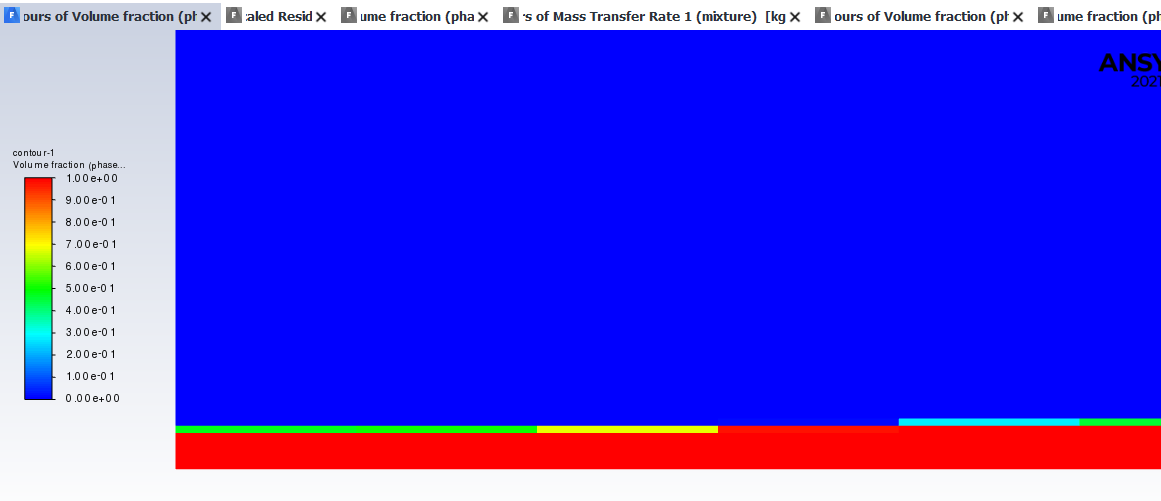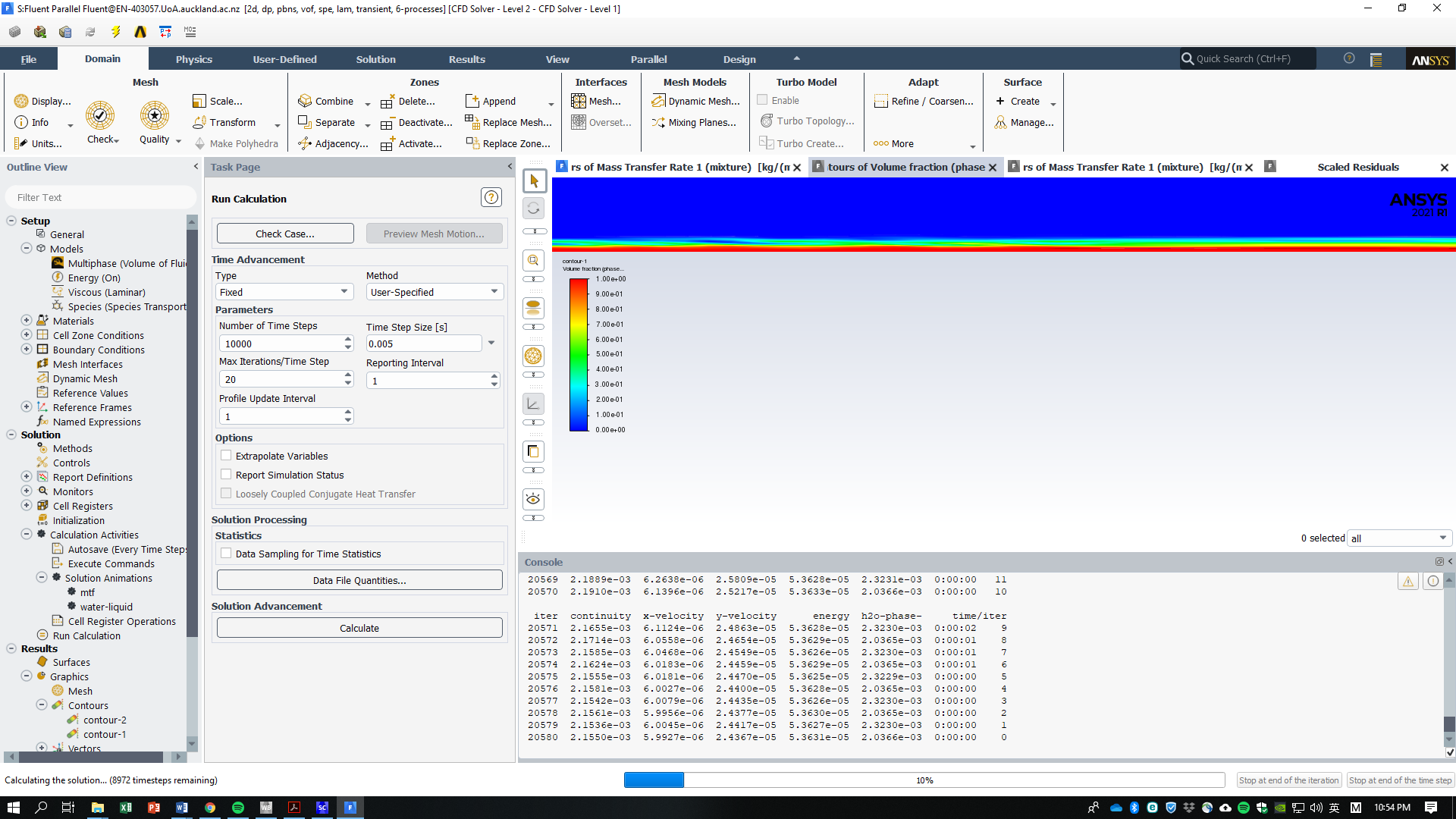TAGGED: evaporation-condensation, fluent, multiphase, vof
-
-
June 27, 2021 at 11:10 am
b404957074
SubscriberHi everyone,
I am trying to simulate the natural evaporation of a thin water film. Basically, there is dry air passing through above the water liquid film, and the water liquid is expected to evaporate into the dry air.
I used VOF and enabled the sharp interface and interfacial anti-diffusion, as well the evaporation-condensation Lee model.
However, as the picture shows, the interface between the water liquid and the air (the air is the mixture of water vapour and dry air) is not "sharp" at all. Instead, there is a gradient of volume fraction of water liquid. How could this be? I expected the interface should only occupy one layer of cells, which mean except for one layer of cells, other cells should be either 0 volume fraction of water liquid or 1 volume fraction.
Could somebody please help? Thanks
Regards
June 28, 2021 at 6:47 amaitor.amatriain
SubscriberWhat is our maximum Courant number? Could you post some pictures of your mesh? (If possible, superimposed with the volume fraction contour)
June 28, 2021 at 8:08 amAmine Ben Hadj Ali
Ansys EmployeeLee Model is not the right model to model this: One can use it but as you are an academic user you should be aware that the mass transfer you want to model is concentration driven.
June 28, 2021 at 8:23 amb404957074
SubscriberHi DrAmine Thanks for your comment, but I don't understand. At the end of the day, it is an evaporation process, isn't it? Could you please elaborate?
I have written my own code to deal with the saturation temperature.
If so what do you recommend? species mass transport?
Regards
June 28, 2021 at 8:28 amAmine Ben Hadj Ali
Ansys EmployeeIt is an evaporation process but not a boiling process. So one expect mass transfer even below the boiling point.
June 28, 2021 at 8:32 amb404957074
SubscriberI understand, that the reason why I used my own code to deal with the saturation temperature. The UDF I used describes the relationship between water vapour pressure and saturation temperature.
As the pic shows, evaporation does happen.
June 28, 2021 at 8:35 amb404957074
SubscriberHi Aitor My inlet velocity is 1 m/s, mesh size is 0.002 m, the time step is 0.01 at the moment. The Courant number is around 5. I know it is a bit higher than what it should be, but as you may already know, natural evaporation is quite a slow process, hence I want to time step to be as large as possible.

June 28, 2021 at 8:37 amb404957074
SubscriberI would like to try up species mass transfer if you consider it is a better way. However, can I ask if I need UDF as well? Since my "air" is a mixture of "dry air" and "water vapour".
June 28, 2021 at 8:45 amAmine Ben Hadj Ali
Ansys EmployeeIf you are using UDF to relate the saturation temperature to partial pressure then it is already a good thin.
Do you need to use VOF? Why not relying on a thin film model theory and using the built-in mass transfer mechanisms there?
June 28, 2021 at 8:57 amb404957074
SubscriberI would like to take the "thin" as "thing", haha...
Do you mean the Eulerian wall film model (something like that I do not really remember the correct name)?
I haven't used that before, but the thing is if I do not use any multiphase model (mixture or VOF), then how can I set up the mass transfer mechanism? What do you mean by built-in mass transfer though?
Thanks!
June 28, 2021 at 10:01 amAmine Ben Hadj Ali
Ansys EmployeeEulerian Wall Film Model does have built-in models for mass transfer.
VOF and Phase Change: Actually you need to have a diffuse interface otherwise you do not have any mass transfer. Now show with nodes values OFF the VOF distribution in the interfacial cells (perhaps a time mean).
June 28, 2021 at 10:24 amb404957074
SubscriberHere you go, after switching the node values off, it seems more reasonable. However, the evaporation rate should be well-tuned through the experiment.
The pic shows the result after 72 seconds of simulation. The thickness of the water layer dropped down from 0.8 mm to 0.4 mm.
I will dig a bit deeper into Eulerian Wall Film later on. But a Diffuse interface? How to set that up?

June 28, 2021 at 4:32 pmAmine Ben Hadj Ali
Ansys EmployeeNode values are sometimes confusing but they only affect post processing (node neighboors are used for some internal stuff in coding). There are some way to diffuse interfaces. If your Film is thin and laminar ewf is good way.
Viewing 12 reply threads- The topic ‘VOF does not show a sharp interface’ is closed to new replies.
Innovation SpaceTrending discussionsTop Contributors-
4633
-
1535
-
1386
-
1225
-
1021
Top Rated Tags© 2025 Copyright ANSYS, Inc. All rights reserved.
Ansys does not support the usage of unauthorized Ansys software. Please visit www.ansys.com to obtain an official distribution.
-












